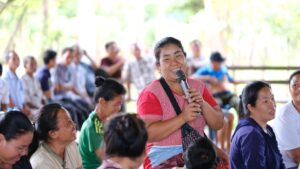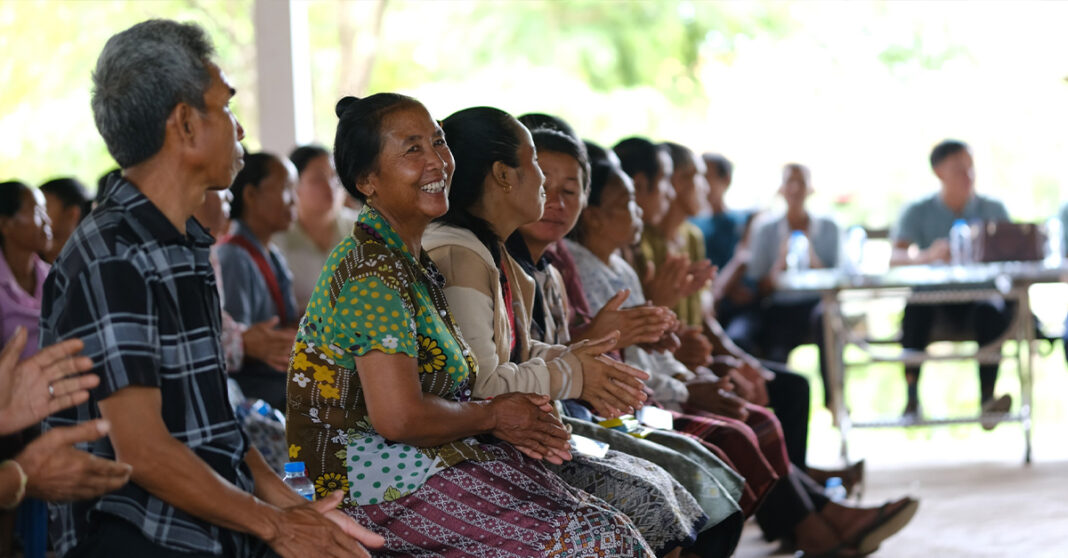SDC – At a community hall shaded by a tin roof and framed by paddy fields, more than two hundred villagers from Ban Nam Deua gather on an early warm morning.
Some arrive on foot, others by motorbike. Blue plastic chairs line the hall, filled with young mothers, village elders, and community leaders.
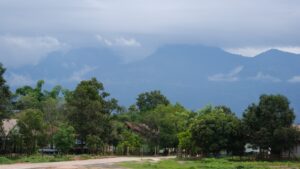
Just before the session begins, a facilitator lifts the microphone and asks, “Would anyone like to sing?”
As a familiar tune rolls across the karaoke screen, the room changes. Smiles spread through the crowd. What had felt like a meeting suddenly becomes a community moment, a warm, participatory, yet familiar one. It is the perfect way to begin talking about something as serious as land rights.
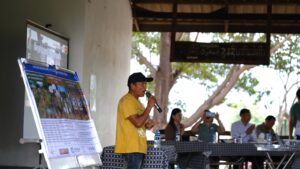
Here in Ban Nam Deua, land is not just territory. It is the foundation of life, for farming, for inheritance, for stability. Yet for decades, many villagers lived on land without formal rights, with unclear boundaries and limited legal knowledge. When disputes arose, they rarely had the tools to fight back.
“I have been farming on the same plot of land for decades,” said Bounthanh Seephantha. “Then one day, someone came, measured it, fenced it, and said it was theirs. We had no knowledge, no title, no way to stop it.”
Her friend, Loun Makmanee, bravely added her own experience after hearing Bounthanh speak.
“A neighbor crossed the boundary into my land,” she said quietly. “But I didn’t know how to speak up, so I just stayed quiet.”
These women, and many others from disadvantaged and ethnic groups, are now slowly finding their voice. As their awareness of rights to land and natural resources grows, so does their confidence, even the quietest voices are beginning to speak for their land and future.
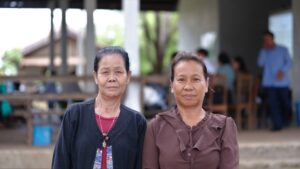
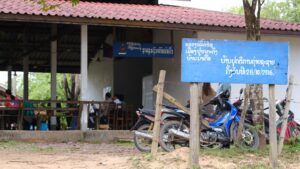
This shift didn’t happen overnight. It is the result of a multi-year effort under the Public Information and Awareness Services for Vulnerable Communities (PIASVC) project supported by Switzerland and the World Bank, implemented by Helvetas and Department of Land, Ministry of Natural Resource and Environment and delivered in Ban Nam Deua by the Association for Development of Women and Legal Education (ADWLE), one of eleven civil society organizations across Laos working under this project.
PIASVC is designed to reach over 30,000 people in eight provinces. In Pakkading District alone, it aims to reach 6,000 people across 12 villages, with 4,100 gaining deeper awareness of land and natural resource rights.
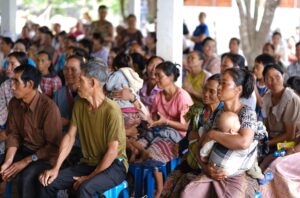
The success of this work lies in the hands of many local change agents. 120 village-based facilitators from Pakkading have been trained to lead local sessions, including Thongthee Douangdee.
“Before, I was too shy to even hold a mic. Now I lead awareness sessions and this is my fourth one so far. I help people with land conflicts and I am proud of who I have become.”
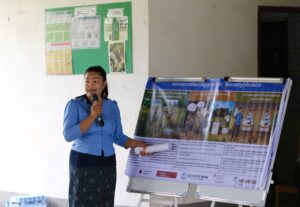
For this particular district, over 90 trained individuals are now trusted sources of basic legal guidance within their communities.
The Village Mediation Committees have also grown stronger with multiple rounds of training helping more than 100 members, over 30 are women to confidently mediate disputes at the village level, where solutions are more accessible and trusted.
“We don’t just lead,” said Bounlai Khamsoukthavong, the village chief. “We follow and we listen. That’s how we earned trust.”
“People now understand different types of land use. They talk about inheritance, about putting both husband and wife on land titles and conflicts have dropped even at home. Land use within the nearby protected forest has also improved and villagers now understand where they can and cannot go, and respect the rules accordingly” he added.
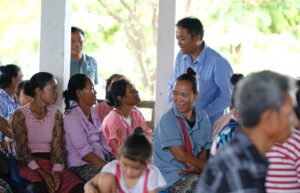
Village Chief Bounlai engages directly with villagers, reflecting the trust and open dialogue fostered through the project. Photo: SDC/Vannaseng Insal
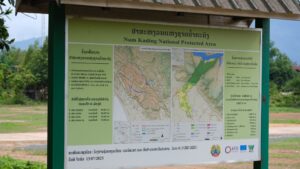
The change in Ban Nam Deua is not happening in isolation. It is part of a broader, long-term vision supported by Switzerland where community knowledge, legal empowerment, land registration, sustainable management, and policy reform all move in the same direction.
While projects like PIASVC build awareness and help resolve disputes at the village level, other Swiss-supported efforts work in tandem to strengthen the land system as a whole.
Land titles are being systematically formalized through the Enhancing Systematic Land Registration (ESLR) initiative, while the Land for Life project focuses on ensuring that land is used productively and responsibly with communities at the center of investment decisions.
The Mekong Region Land Governance (MRLG) initiative contributes by creating space for dialogue, recognizing customary land practices, and encouraging policy reform across the region.
Newer work under the Land Management and Decentralised Planning (LMDP) programme helps extend legal clarity and governance into forested areas, often home to the most vulnerable communities.
Together, these efforts reflect a Swiss cooperation approach that sees land not only as a legal issue, but as a foundation for social cohesion, gender equality, economic opportunity, and climate resilience.
Strengthening land governance from the household to the national and regional level means that when someone like Bounthanh faces a land conflict or when Thongthee leads a session, they are both participating in a larger shift, one that aims to make land systems fairer, more transparent and truly inclusive. This is why the work of Switzerland remains so important for the region to ensure that progress is not only made but sustained where it matters most.
At the end of the session, the village hall is buzzing.
Children run past the flipcharts while farmers chat quietly by the doorway. Loun, standing beside her friend, smiled as she reflected, “we are just simple villagers. But now we know more. And that means we slowly stepped beyond darkness and it seems a bit brighter now.”
